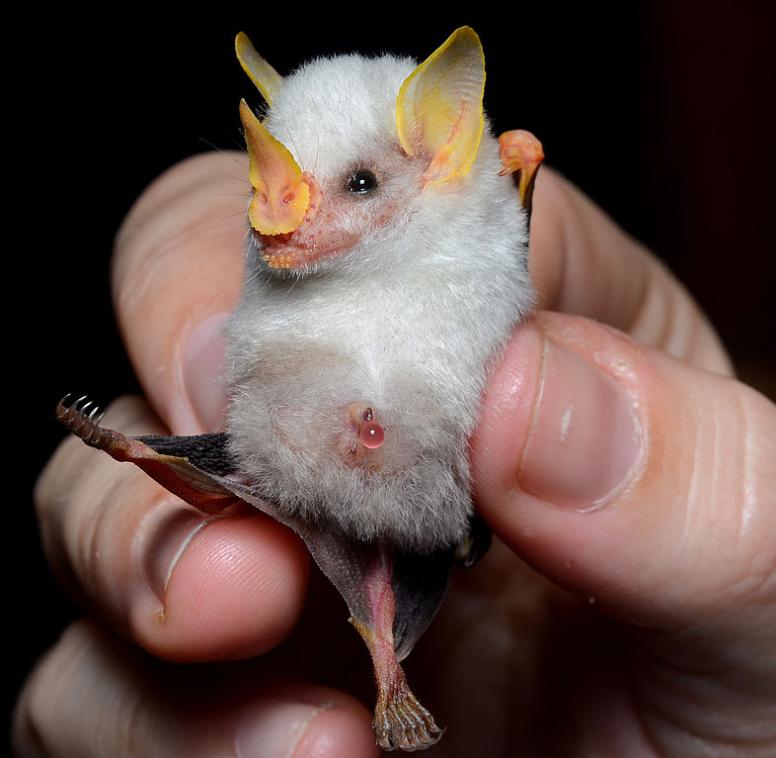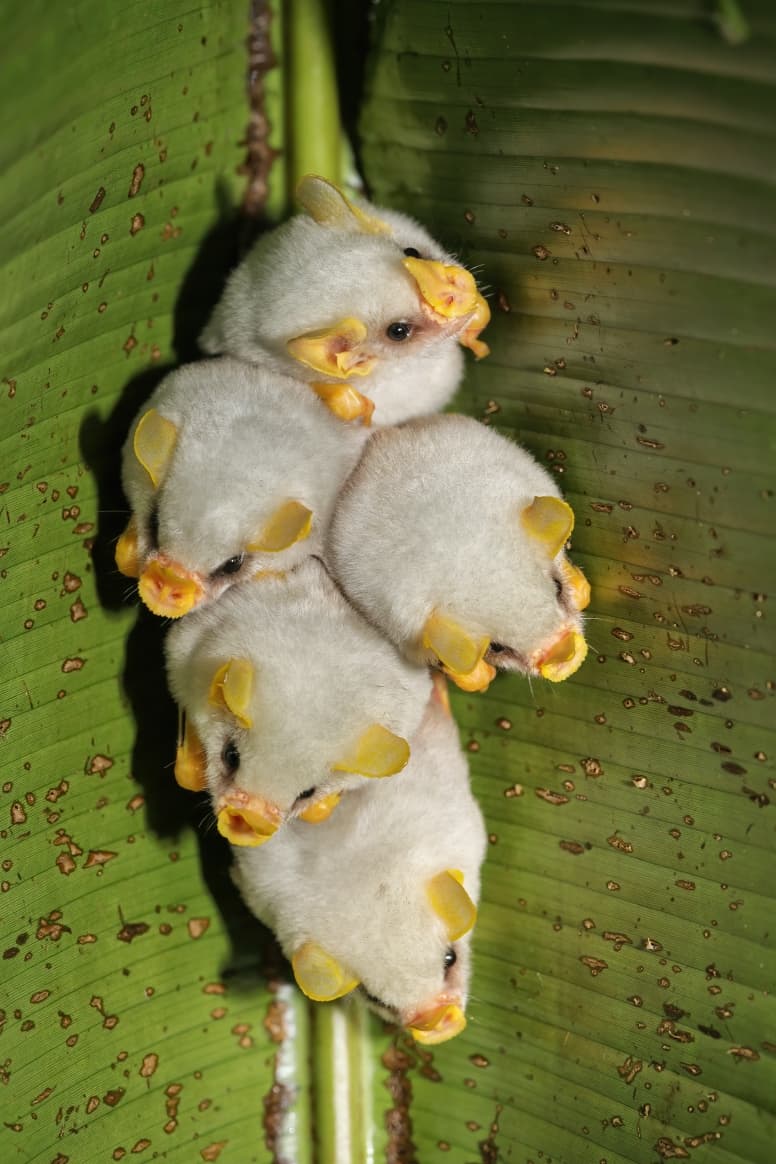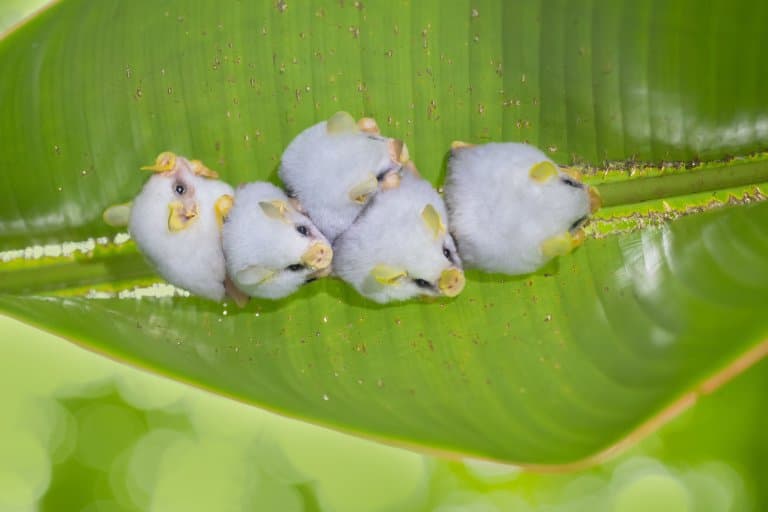Honduran White Bat Profile
The Honduran white bat is also known as the Caribbean white tent-making bat and is a species of bat that is found in Honduras, Nicaragua, Costa Rica and western parts of Panama.
It is unique to all bats in that it has a distinctive, completely white fur which occurs in only six of well over 1,300 species of bat. They have a yellow leaf-shaped nose and ears, and a black membrane on their wings.
It gets the ‘tent-making’ name as it builds ‘tents’ out of plant leaves, that it first cuts carefully with its teeth. These bats roost in the tents during daylight.
 Photo credit Geoff Galice.
Photo credit Geoff Galice.
Honduran White Bat Facts Overview
| Habitat: | Rainforests |
| Location: | Honduras, Nicaragua, Costa Rica, Panama |
| Lifespan: | 15 – 20 years |
| Size: | 4 – 5 cm |
| Weight: | 5 – 6 grams (0.18–0.21 oz) |
| Color: | White fur, yellow ears & nose |
| Diet: | Fruit (figs in particular) |
| Predators: | Snakes, possums, owls |
| Top Speed: | 20 mph (15 kph) |
| No. of Species: |
1 |
| Conservation Status: |
Near threatened |
The Honduran white at is one of only two small species of bats that are frugivorous – meaning, it feeds on fruit. In fact, it prefers one single variety of fig and seeks fig trees that are close to their roosts.
The average home range of one of these bats is less than a quarter square mile and scientists struggle to see how this bat can survive on such a limited food source. There are suggestions that there are likely supplemental food sources involved.
The reproductive behaviors of the Honduran white bat are mostly unknown. Speculation puts births at occurring in April and September. Pregnant females have been noted in Costa Rica in February, March, June, July and August.
The litter size is usually just a single pup with mothers returning to the tent roost up to six times in an evening to feed their pups which can fly at 3 to 4 weeks of age. There are also suggestions that the female Honduran white bat can become pregnant twice in a calendar year although this has yet to have been completely proven.
Over sixty years passed between the discovery of the first Honduran white bat in 1898 and the second discovery in 1963.
The bat is currently listed by the IUCN as near-threatened and it meets this category criteria simply because the population of this flying creature is in a ‘significant decline.’ However, that being said, the Honduran white bat is also on the verge of qualifying for the designation of ‘vulnerable.’
Habitat loss for the Honduran white bat in the form of conversion to farmland and an expanding human population are the main threats to this white bat species. As it feeds primarily on one species of fig, habitat loss will impact the population numbers greatly.
Interesting Honduran White Bat Facts
1. They nest in Heliconia plant leaves, by building upside-down V-shaped ‘tents’
By cutting along the veins of the leaf with their teeth, they force them to collapse into a v-shape, which is enough for anywhere between 1 and 15 bats to shelter and sleep. They huddle up together.

New tents are created regularly, as cutting the leaves causes them die.
2. The leaf tents help protect them from rain, hot sun, and predators
It clings to the roof of its tent and the leaves are generally 6 feet off the rainforest floor and dense, hidden away from most danger.

3. The white fur of a Honduran white bat makes them ‘invisible’
As sunlight filters through the green leaves of a white bat roost, the whitish fur coat of this bat appears green – making it virtually disappear if it remains still.
4. The Honduran white bat will remain motionless in their tent
They are so confident that they are protected in their roost that the tiny bat will not fly away or try to escape from a threat unless the stem of a leave the roost is made from is actually disturbed.

5. Honduran white bats rely on echolocation to navigate at night, but also more traditional means for communication
Rather than relying on sonar as many bats do, Honduran white bats interact with each other through touch and visual means, too. 1
6. The Honduran white bat has a built-in UV protective coat
A black membrane that is thick and covers the skull of the bat, is believed to shield it from the effects of the sun’s ultraviolet light.
7. They have an appetite for figs, and a particular species, the ‘Ficus colubrinae
While other species of figs are occasionally consumed, the Honduran white bat prefers Ficus colubrinae trees that are high-quality, or produce many fruits all at once.
Because it’s so focused on eating figs, it’s less adept at foraging and eating other fruits as well.
8. The Honduran white bat leads a polygamous lifestyle
Each tent will be home to a single male and up to six females. During the mating season, the male bat will mate with the group of females. 2
9. The wingspan of this pygmy bat is no more than 4 inches (10 cms)
They really are tiny.
View this post on Instagram
10. It is one of the few bat species that does not have a tail
Bats typically use their tail for take off, to give extra thrust and lift.
11. They don’t make good pets
Aside from the tiny size and space required to keep them, replicating the exact environment for a Honduran white bat to survive in captivity would be close to impossible.
Even if you had access to an endless supply of the one fig they eat, failing to match the roosting requirements would likely lead to health problems with the bats.
12. The Honduran white bat is a contradiction to the bat stereotype
Not only does this bat not live in a cave, it is not dark coloured to assist with helping to shield it from discovery from predators.
These are also very small bats with brightly coloured noses and ears.
13. Its species name ‘alba’ comes from Latin ‘albus’ meaning ‘white’
After it’s distinctive bright white fur across its body.
14. They are being researched to combat macular degeneration in humans
Its yellow nose-leaf, ears are and lips are produced by ‘carotenoids’, and it’s the only known mammal to have high enough concentrations of this pigment to change skin color.
This is a result of the Honduran white bat being able to convert free lutein to esterified lutein. Lutein is a key carotenoid pigment in preventing damage to the retina and vision.
Researchers hope that studying the bats will benefit potential treatments for humans with blurred, and no vision in the center of their visual fields.
15. Sadly, they are on the verge of being classed as ‘vulnerable’
The size of their population is unknown, but its classified is decreasing due to urbanisation.
In Costa Rica, the species has declined due to the growth of the human population, and subsequent loss of habitat.3
Honduran White Bat Fact-File Summary
Scientific Classification
| Kingdom: | Animalia |
| Phylum: | Chordata |
| Class: | Mammalia |
| Order: | Chiroptera |
| Family: | Phyllostomidae |
| Genus: | Ectophylla |
| Species Name: |
Ectophylla Alba |
Fact Sources & References
- Erin H Gillam (2013), “Social Calls Produced within and near the Roost in Two Species of Tent-Making Bats, Dermanura watsoni and Ectophylla alba“, PLOS One.
- Manfredo Alejandro Turcios (2020), “Reproductive, morphometric, and roosting description of the Honduran white bat, Ectophylla alba (Chiroptera: Phyllostomidae), in Honduras“, Research Gate.
- “Ectophylla alba”, via the IUCN Red List.
